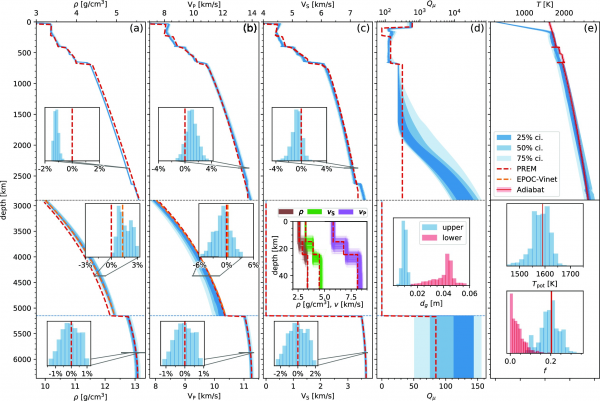Geophysicists and planetary scientists need to know the gross physical properties of the planet in order to model Earth processes, like the travel times of disturbances from earthquakes and how the tectonic plates move. Since 1981, they used a model called PREM. Subsequently, improved measurement techniques and accumulated observations provided more and better data to improve it. A collaboration involving ELSI recently built and published a new reference Earth model, SC-REM, that updates PREM. The new structure indicates that the liquid outer core’s is not radially homogenous, and the density jump at the solid inner core is smaller than previously thought.

A research team, including ELSI’s George Helffrich (retired), inverted a large set of normal-mode centre-frequencies and quality (attenuation) factors, including astronomic-geodetic data (mass, moment of inertia and tidal response), using self-consistently built models of the radial elastic and anelastic seismic structure of the Earth. The motivation was to use the further accumulation of observational constraints since PREM was built and to capitalise on the methodological advances that reduced the uncertainty in astrometric-geodetic observations to update the model. The result is a model called SC-REM: a self-consistent reference Earth model.
The model’s self-consistency arises from the way it is constructed: a mineralogical model underlies all of the calculated properties from which temperature, density and seismic wave speeds are calculated. In addition, the minerals deform according to a specified viscoelastic, grain-size-dependent model. This captures the deformation of the Earth from seismic time scales (seconds to hours) to decadal time scales. Another useful feature of the model is that it provides uncertainties for density and seismic wave speed at each level. These were unspecified in PREM.
Apart from these usability characteristics, the new model confirms a few features of the structure of research interest. Firstly, the mantle becomes slightly less dense, and the core becomes more dense. The top of the outer core appears to have an anomalous gradient that suggests a change in composition near its boundary with the mantle. Moreover, the density changes at the inner core boundary, where the core solidifies, is smaller than PREM. This probably means that the energy source driving the Earth’s magnetic field must arise by some mechanism other than the inner core’s crystallisation. The model summarises the observational data upon which future researchers may improve our knowledge of the Earth’s internal processes.

| Journal | Geophysical Journal International |
| Title of the paper | Self-consistent models of Earth’s mantle and core from long-period seismic and tidal constraints |
| Authors | J. Kemper1, A. Khan1,2, G. Helffrich3, M. van Driel1, D. Giardini1 |
| Affiliations | 1. Institute of Geophysics, ETH Zürich, Zürich 8092, Switzerland 2. Institute of Geochemistry and Petrology, ETH Zürich, Zürich 8092, Switzerland 3. Earth-Life Science Institute (ELSI), Tokyo Institute of Technology, Tokyo 152-8550 , Japan |
| DOI | 10.1093/gji/ggad254 |
| Online published date | 24 June 2023 |
